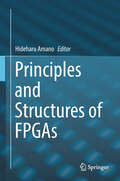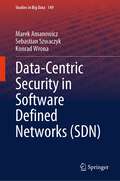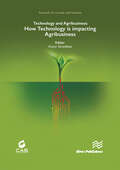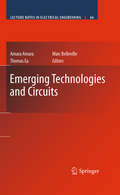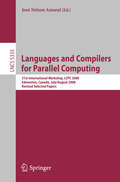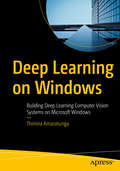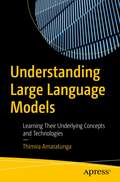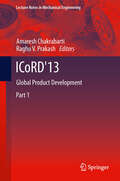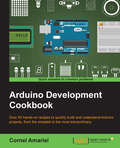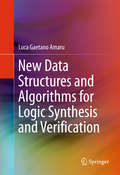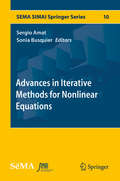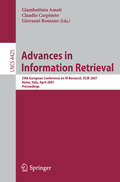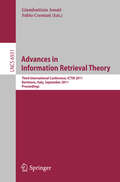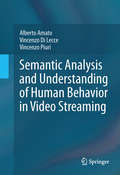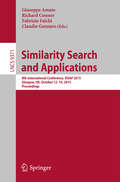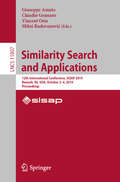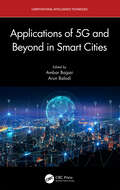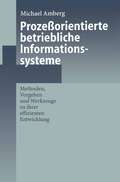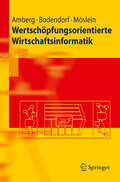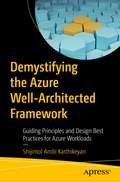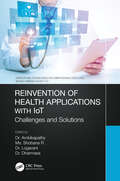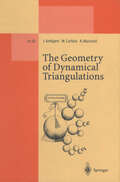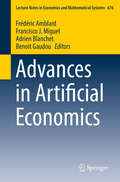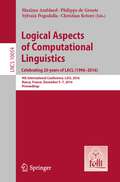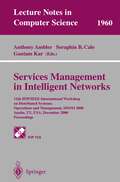- Table View
- List View
Principles and Structures of FPGAs
by Hideharu AmanoThis comprehensive textbook on the field programmable gate array (FPGA) covers its history, fundamental knowledge, architectures, device technologies, computer-aided design technologies, design tools, examples of application, and future trends. Programmable logic devices represented by FPGAs have been rapidly developed in recent years and have become key electronic devices used in most IT products. This book provides both complete introductions suitable for students and beginners, and high-level techniques useful for engineers and researchers in this field. Differently developed from usual integrated circuits, the FPGA has unique structures, design methodologies, and application techniques. Allowing programming by users, the device can dramatically reduce the rising cost of development in advanced semiconductor chips. The FPGA is now driving the most advanced semiconductor processes and is an all-in-one platform combining memory, CPUs, and various peripheral interfaces. This book introduces the FPGA from various aspects for readers of different levels. Novice learners can acquire a fundamental knowledge of the FPGA, including its history, from Chapter 1; the first half of Chapter 2; and Chapter 4. Professionals who are already familiar with the device will gain a deeper understanding of the structures and design methodologies from Chapters 3 and 5. Chapters 6–8 also provide advanced techniques and cutting-edge applications and trends useful for professionals. Although the first parts are mainly suitable for students, the advanced sections of the book will be valuable for professionals in acquiring an in-depth understanding of the FPGA to maximize the performance of the device.
Data-Centric Security in Software Defined Networks (Studies in Big Data #149)
by Marek Amanowicz Sebastian Szwaczyk Konrad WronaThe book focuses on applying the data-centric security (DCS) concept and leveraging the unique capabilities of software-defined networks (SDN) to improve the security and resilience of corporate and government information systems used to process critical information and implement business processes requiring special protection. As organisations increasingly rely on information technology, cyber threats to data and infrastructure can significantly affect their operations and adversely impact critical business processes. Appropriate authentication, authorisation, monitoring, and response measures must be implemented within the perimeter of the system to protect against adversaries. However, sophisticated attackers can compromise the perimeter defences and even remain in the system for a prolonged time without the owner being aware of these facts. Therefore, new security paradigms such as Zero Trust and DCS aimto provide defence under the assumption that the boundary protections will be breached. Based on experience and lessons learned from research on the application of DCS to defence systems, the authors present an approach to integrating the DCS concept with SDN. They introduce a risk-aware approach to routing in SDN, enabling defence-in-depth and enhanced security for data in transit. The book describes possible paths for an organisation to transition towards DCS, indicating some open and challenging issues requiring further investigation. To allow interested readers to conduct detailed studies and evaluate the exemplary implementation of DCS over SDN, the text includes a short tutorial on using the emulation environment and links to the websites from which the software can be downloaded.
Technology and Agribusiness: How the Technology is Impacting the Agribusiness
by Amara Amara Yen-Kuang Chen Yoshifumi NishioThe world population is growing, and it is expected that in 2050 there will be 9.7 billion inhabitants on the Earth. According to FAO (United Nations, Food and Agriculture Organization) we need to increase the productivity of agriculture by between 50% and 70% to be able to feed the world population in 2050. Other researchers think that reducing the wastage of food may be enough to handle the 2050 population.Several factors must be considered to ensure that humanity is able to feed the world’s population in 2050 and beyond.• Less arable land: As cities are growing, the space available for agriculture is shrinking.• Climate change: Dramatic impacts on agribusiness.• Role of agribusiness on GHG emissions.• Planetary boundaries and the role of agribusiness.• Availability of freshwater.• Soil degradation.The seasonal school presents and discusses the major problems that agribusiness is facing and the different technologies that can be applied to solve and improve such issues. Specific case studies are presented along with the technological solutions that have been applied to solve or minimize the impact.Agribusiness covers different topics such as arable farming, dairy farming, fruits, vegetables, meat, etc. Each of these domains has different needs that can be addressed through smart agriculture technologies such as circuits and systems. Also, these domains affect the sustainability of the planet as they impact at least 4 out of the 9 planetary boundaries.
Emerging Technologies and Circuits (Lecture Notes in Electrical Engineering #66)
by Amara Amara Thomas Ea Marc BellevilleEmerging Technologies and Circuits contains a set of outstanding papers, keynote and tutorials presented during 3 days at the International Conference On Integrated Circuit Design and Technology (ICICDT) held in June 2008 in Minatec, Grenoble.
Languages and Compilers for Parallel Computing: 21th International Workshop, LCPC 2008, Edmonton, Canada, July 31 - August 2, 2008, Revised Selected Papers (Lecture Notes in Computer Science #5335)
by José Nelson AmaralIn 2008 the Workshop on Languages and Compilers for Parallel Computing left the USA to celebrate its 21st anninversary in Edmonton, Alberta, Canada. Following its long-established tradition, the workshop focused on topics at the frontierofresearchanddevelopmentinlanguages,optimizingcompilers,appli- tions, and programming models for high-performance computing. While LCPC continues to focus on parallel computing, the 2008 edition included the pres- tation of papers on program analysis that are precursors of high performance in parallel environments. LCPC 2008 received 35 paper submissions. Eachpaper received at least three independent reviews, and then the papers and the referee comments were d- cussed during a Program Committee meeting. The PC decided to accept 18 papers as regular papers and 6 papers as short papers. The short papers appear at the end of this volume. The LCPC 2008 program was fortunate to include two keynote talks. Keshav Pingali’s talk titled “Amorphous Data Parallelism in Irregular Programs” - gued that irregular programs have data parallelism in the iterative processing of worklists. Pingali described the Galois system developed at The University of Texas at Austin to exploit this kind of amorphous data parallelism. The second keynote talk, “Generic ParallelAlgorithms in Threading Building Bocks (TBB),” presented by Arch Robison from Intel Corporation addressed very practical aspects of using TBB, a production C++ library, for generic p- allel programming and contrasted TBB with the Standard Template Library (STL).
Deep Learning on Windows: Building Deep Learning Computer Vision Systems on Microsoft Windows
by Thimira AmaratungaBuild deep learning and computer vision systems using Python, TensorFlow, Keras, OpenCV, and more, right within the familiar environment of Microsoft Windows. The book starts with an introduction to tools for deep learning and computer vision tasks followed by instructions to install, configure, and troubleshoot them. Here, you will learn how Python can help you build deep learning models on Windows. Moving forward, you will build a deep learning model and understand the internal-workings of a convolutional neural network on Windows. Further, you will go through different ways to visualize the internal-workings of deep learning models along with an understanding of transfer learning where you will learn how to build model architecture and use data augmentations. Next, you will manage and train deep learning models on Windows before deploying your application as a web application. You’ll also do some simple image processing and work with computer vision options that will help you build various applications with deep learning. Finally, you will use generative adversarial networks along with reinforcement learning. After reading Deep Learning on Windows, you will be able to design deep learning models and web applications on the Windows operating system. What You Will LearnUnderstand the basics of Deep Learning and its historyGet Deep Learning tools working on Microsoft WindowsUnderstand the internal-workings of Deep Learning models by using model visualization techniques, such as the built-in plot_model function of Keras and third-party visualization toolsUnderstand Transfer Learning and how to utilize it to tackle small datasetsBuild robust training scripts to handle long-running training jobsConvert your Deep Learning model into a web applicationGenerate handwritten digits and human faces with DCGAN (Deep Convolutional Generative Adversarial Network)Understand the basics of Reinforcement Learning Who This Book Is For AI developers and enthusiasts wanting to work on the Windows platform.
Understanding Large Language Models: Learning Their Underlying Concepts and Technologies
by Thimira AmaratungaThis book will teach you the underlying concepts of large language models (LLMs), as well as the technologies associated with them. The book starts with an introduction to the rise of conversational AIs such as ChatGPT, and how they are related to the broader spectrum of large language models. From there, you will learn about natural language processing (NLP), its core concepts, and how it has led to the rise of LLMs. Next, you will gain insight into transformers and how their characteristics, such as self-attention, enhance the capabilities of language modeling, along with the unique capabilities of LLMs. The book concludes with an exploration of the architectures of various LLMs and the opportunities presented by their ever-increasing capabilities—as well as the dangers of their misuse. After completing this book, you will have a thorough understanding of LLMs and will be ready to take your first steps in implementing them into your own projects. What You Will Learn Grasp the underlying concepts of LLMsGain insight into how the concepts and approaches of NLP have evolved over the yearsUnderstand transformer models and attention mechanismsExplore different types of LLMs and their applicationsUnderstand the architectures of popular LLMsDelve into misconceptions and concerns about LLMs, as well as how to best utilize them Who This Book Is For Anyone interested in learning the foundational concepts of NLP, LLMs, and recent advancements of deep learning
ICoRD'13: Global Product Development (Lecture Notes in Mechanical Engineering)
by Amaresh Chakrabarti and Raghu V. PrakashThis book showcases over 100 cutting-edge research papers from the 4th International Conference on Research into Design (ICoRD’13) – the largest in India in this area – written by eminent researchers from over 20 countries, on the design process, methods and tools, for supporting global product development (GPD). The special features of the book are the variety of insights into the GPD process, and the host of methods and tools at the cutting edge of all major areas of design research for its support. The main benefit of this book for researchers in engineering design and GPD are access to the latest quality research in this area; for practitioners and educators, it is exposure to an empirically validated suite of methods and tools that can be taught and practiced.
Arduino Development Cookbook
by Cornel AmarieiIf you want to build programming and electronics projects that interact with the environment, this book will offer you dozens of recipes to guide you through all the major applications of the Arduino platform. It is intended for programming or electronics enthusiasts who want to combine the best of both worlds to build interactive projects.
New Data Structures and Algorithms for Logic Synthesis and Verification
by Luca Gaetano AmaruThis book introduces new logic primitives for electronic design automation tools. The author approaches fundamental EDA problems from a different, unconventional perspective, in order to demonstrate the key role of rethinking EDA solutions in overcoming technological limitations of present and future technologies. The author discusses techniques that improve the efficiency of logic representation, manipulation and optimization tasks by taking advantage of majority and biconditional logic primitives. Readers will be enabled to accelerate formal methods by studying core properties of logic circuits and developing new frameworks for logic reasoning engines.
Advances in Iterative Methods for Nonlinear Equations (SEMA SIMAI Springer Series #10)
by Sergio Amat Sonia BusquierThis book focuses on the approximation of nonlinear equations using iterative methods. Nine contributions are presented on the construction and analysis of these methods, the coverage encompassing convergence, efficiency, robustness, dynamics, and applications. Many problems are stated in the form of nonlinear equations, using mathematical modeling. In particular, a wide range of problems in Applied Mathematics and in Engineering can be solved by finding the solutions to these equations. The book reveals the importance of studying convergence aspects in iterative methods and shows that selection of the most efficient and robust iterative method for a given problem is crucial to guaranteeing a good approximation. A number of sample criteria for selecting the optimal method are presented, including those regarding the order of convergence, the computational cost, and the stability, including the dynamics. This book will appeal to researchers whose field of interest is related to nonlinear problems and equations, and their approximation.
Advances in Information Retrieval: 29th European Conference on IR Research, ECIR 2007, Rome, Italy, April 2-5, 2007, Proceedings (Lecture Notes in Computer Science #4425)
by Giambattista Amati Claudio Carpineto Giovanni RomanoThis book constitutes the refereed proceedings of the 29th annual European Conference on Information Retrieval Research, ECIR 2007, held in Rome, Italy in April 2007. The papers are organized in topical sections on theory and design, efficiency, peer-to-peer networks, result merging, queries, relevance feedback, evaluation, classification and clustering, filtering, topic identification, expert finding, XML IR, Web IR, and multimedia IR.
Advances in Information Retrieval Theory: Third International Conference, ICTIR 2011, Bertinoro, Italy, September 12-14, 2011, Proceedings (Lecture Notes in Computer Science #6931)
by Giambattista Amati Fabio CrestaniThis book constitutes the refereed proceedings of the Third International Conference on the Theory of Information Retrieval, ICTIR 2011, held in Bertinoro, Italy, in September 2011. The 25 revised full papers and 13 short papers presented together with the abstracts of two invited talks were carefully reviewed and selected from 65 submissions. The papers cover topics ranging from query expansion, co-occurence analysis, user and interactive modelling, system performance prediction and comparison, and probabilistic approaches for ranking and modelling IR to topics related to interdisciplinary approaches or applications. They are organized into the following topical sections: predicting query performance; latent semantic analysis and word co-occurrence analysis; query expansion and re-ranking; comparison of information retrieval systems and approximate search; probability ranking principle and alternatives; interdisciplinary approaches; user and relevance; result diversification and query disambiguation; and logical operators and descriptive approaches.
Semantic Analysis and Understanding of Human Behavior in Video Streaming
by Alberto Amato Vincenzo Di Lecce Vincenzo PiuriSemantic Analysis and Understanding of Human Behaviour in Video Streaming investigates the semantic analysis of the human behaviour captured by video streaming, and introduces both theoretical and technological points of view. Video analysis based on the semantic content is in fact still an open issue for the computer vision research community, especially when real-time analysis of complex scenes is concerned. This book explores an innovative, original approach to human behaviour analysis and understanding by using the syntactical symbolic analysis of images and video streaming described by means of strings of symbols. A symbol is associated to each area of the analyzed scene. When a moving object enters an area, the corresponding symbol is appended to the string describing the motion. This approach allows for characterizing the motion of a moving object with a word composed by symbols. By studying and classifying these words we can categorize and understand the various behaviours. The main advantage of this approach lies in the simplicity of the scene and motion descriptions so that the behaviour analysis will have limited computational complexity due to the intrinsic nature both of the representations and the related operations used to manipulate them. Besides, the structure of the representations is well suited for possible parallel processing, thus allowing for speeding up the analysis when appropriate hardware architectures are used. A new methodology for design systems for hierarchical high semantic level analysis of video streaming in narrow domains is also proposed. Guidelines to design your own system are provided in this book. Designed for practitioners, computer scientists and engineers working within the fields of human computer interaction, surveillance, image processing and computer vision, this book can also be used as secondary text book for advanced-level students in computer science and engineering.
Similarity Search and Applications: 8th International Conference, SISAP 2015, Glasgow, UK, October 12-14, 2015, Proceedings (Lecture Notes in Computer Science #9371)
by Giuseppe Amato Richard Connor Fabrizio Falchi Claudio GennaroThis book constitutes the proceedings of the 8th International Conference on Similarity Search and Applications, SISAP 2015, held in Glasgow, UK, in October 2015. The 19 full papers, 12 short and 9 demo and poster papers presented in this volume were carefully reviewed and selected from 68 submissions. They are organized in topical sections named: improving similarity search methods and techniques; metrics and evaluation; applications and specific domains; implementation and engineering solutions; posters; demo papers.
Similarity Search and Applications: 12th International Conference, SISAP 2019, Newark, NJ, USA, October 2–4, 2019, Proceedings (Lecture Notes in Computer Science #11807)
by Giuseppe Amato Claudio Gennaro Vincent Oria Miloš RadovanovićThis book constitutes the refereed proceedings of the 12th International Conference on Similarity Search and Applications, SISAP 2019, held in Newark, NJ, USA, in October 2019. The 12 full papers presented together with 18 short and 3 doctoral symposium papers were carefully reviewed and selected from 42 submissions. The papers are organized in topical sections named: Similarity Search and Retrieval; The Curse of Dimensionality; Clustering and Outlier Detection; Subspaces and Embeddings; Applications; Doctoral Symposium Papers.
Applications of 5G and Beyond in Smart Cities (Computational Intelligence Techniques)
by Ambar Bajpai and Arun BalodiThis book explores the potential of 5G technologies and beyond in smart city setups, with the availability of high bandwidths and performance, and low latency. The book starts with an introduction to 5G, along with the challenges, limitations, and research areas in future wireless communication, including the related requirements for transformation of societal paradigms and infrastructure. Applications related to visible light communication, network management in smart cities, the role of 5G in public healthcare, safety, security, and transportation, and existing and planned 6G research frameworks are included. The features of the book include: A broad perspective on 5G communications with a focus on smart cities. Discussion of artificial intelligence in future wireless communication and its applications. A systemic and comprehensive coverage of 6G technologies, challenges, and uses. The role of future wireless communications in safety, health, and transport in smart cities. Case studies of future wireless communication. This book is aimed at researchers and professionals in communications, signal processing, cyber-physical systems, and smart cities.
Prozeßorientierte betriebliche Informationssysteme: Methoden, Vorgehen und Werkzeuge zu ihrer effizienten Entwicklung
by Michael AmbergAusgangspunkt dieses Buches ist die Fragestellung, wodurch prozeßorientierte betriebliche Informationssysteme gekennzeichnet sind und was sie für Unternehmen zukünftig so interessant macht. Anschließend wird erläutert, wie rechnergestützte prozeßorientierte Informationssysteme verwirklicht werden können. Das Buch präsentiert außerdem einen Modellierungsansatz - bestehend aus Methode, Vorgehen und Werkzeugen - zur effizienten und effektiven Analyse und Gestaltung derartiger Informationssysteme.
Wertschöpfungsorientierte Wirtschaftsinformatik (Springer-Lehrbuch)
by Michael Amberg Freimut Bodendorf Kathrin M. MösleinDie Informationstechnologie (IT) wurde lange Zeit nur in ihrer Unterstützungs- und Ermöglichungsfunktion wahrgenommen. Inzwischen hat sich die Informationstechnologie jedoch zu einem eigenständigen Treiber der Wertschöpfung entwickelt. Mit dem Lehrbuch liefern die Autoren eine systematische Einführung in die Wirtschaftsinformatik und regen zugleich zu einer wertschöpfungsorientierten Gestaltung an. Prägnante Praxisbeispiele zeigen die Anwendungen in Unternehmen und auf Märkten, illustrieren Erfahrungen und stellen so den Praxisbezug her.
Demystifying the Azure Well-Architected Framework: Guiding Principles and Design Best Practices for Azure Workloads
by Shijimol Ambi KarthikeyanUse the Azure well-architected framework to deploy your workloads in Azure and align them with Microsoft recommended best practices. This book takes a deep dive into the five architecture elements (cost optimization, performance efficiency, operational excellence, reliability, and security) and provides practical guidance on incorporating them into your architecture.The book starts with an introduction to the relevance of the well-architectured framework and why it should form the baseline of your design decisions when deploying applications in Azure. You will learn how customers can optimize the cost of deployment in Azure and understand all aspects of implementation. The book takes you through the practices and processes to be followed to run applications smoothly and you will understand the end-to-end process of design, deployment, and monitoring. You will go through paradigms for designing environments to meet different performance demands. The book covers how to build resilient and highly available applications in Azure with a sample configuration for monitoring. And you will learn how to enable security to ensure confidentiality and integrity of workloads in Azure.After reading this book, you will know the practical nuances of designing high-performing applications in the Microsoft cloud. What You Will LearnUnderstand the five pillars of the well-architected frameworkUse tools and services to optimize costDesign for performance efficiencyDeal with threat vectors in the cloudWho This Book Is ForSolution architects and cloud teams in Azure
Reinvention of Health Applications with IoT: Challenges and Solutions (Demystifying Technologies for Computational Excellence)
by Dr A. AmbikapathyThis book discusses IoT in healthcare and how it enables interoperability, machine-to-machine communication, information exchange, and data movement. It also covers how healthcare service delivery automates patient care with the help of mobility solutions, new technologies, and next-gen healthcare facilities with challenges faced and suggested solutions prescribed. Reinvention of Health Applications with IoT: Challenges and Solutions presents the latest applications of IoT in healthcare along with challenges and solutions. It looks at a comparison of advanced technologies such as Deep Learning, Machine Learning, and AI and explores the ways they can be applied to sensed data to improve prediction and decision-making in smart health services. It focuses on society 5.0 technologies and illustrates how they can improve society and the transformation of IoT in healthcare facilities to support patient independence. Case studies are included for applications such as smart eyewear, smart jackets, and smart beds. The book will also go into detail on wearable technologies and how they can communicate patient information to doctors in medical emergencies. The target audiences for this edited volume is researchers, practitioners, students, as well as key stakeholders involved in and working on healthcare engineering solutions.
The Geometry of Dynamical Triangulations (Lecture Notes in Physics Monographs #50)
by Jan Ambjorn Mauro Carfora Annalisa MarzuoliThe express purpose of these lecture notes is to go through some aspects of the simplicial quantum gravity model known as the dynamical triangula tions approach. Emphasis has been on laying the foundations of the theory and on illustrating its subtle and often unexplored connections with many distinct mathematical fields ranging from global Riemannian geometry, to moduli theory, number theory, and topology. Our exposition will concentrate on these points so that graduate students may find in these notes a useful exposition of some of the rigorous results one can -establish in this field and hopefully a source of inspiration for new exciting problems. We try as far as currently possible to expose the interplay between the analytical aspects of dynamical triangulations and the results of Monte Carlo simulations. The techniques described here are rather novel and allow us to address points of current interest in the subject of simplicial quantum gravity while requiring very little in the way of fancy field-theoretical arguments. As a consequence, these notes contain mostly original and until now unpublished material, which will hopefully be of interest both to the expert practitioner and to graduate students entering the field. Among the topics addressed here in considerable detail are the following. (i) An analytical discussion of the geometry of dynamical triangulations in dimensions n == 3 and n == 4.
Advances in Artificial Economics (Lecture Notes in Economics and Mathematical Systems #676)
by Frédéric Amblard Francisco J. Miguel Adrien Blanchet Benoit GaudouThe book presents a peer-reviewed collection of papers presented during the 10th issue of the Artificial Economics conference, addressing a variety of issues related to macroeconomics, industrial organization, networks, management and finance, as well as purely methodological issues. The field of artificial economics covers a broad range of methodologies relying on computer simulations in order to model and study the complexity of economic and social phenomena. The grounding principle of artificial economics is the analysis of aggregate properties of simulated systems populated by interacting adaptive agents that are equipped with heterogeneous individual behavioral rules. These macroscopic properties are neither foreseen nor intended by the artificial agents but generated collectively by them. They are emerging characteristics of such artificially simulated systems.
Logical Aspects of Computational Linguistics. Celebrating 20 Years of LACL: 9th International Conference, LACL 2016, Nancy, France, December 5-7, 2016, Proceedings (Lecture Notes in Computer Science #10054)
by Maxime Amblard Philippe De Groote Sylvain Pogodalla Christian RetoréEdited under the auspices of the Association of Logic, Language andInformation (FoLLI), this book constitutes the refereed proceedings ofthe 20th anniversary of the International Conference on LogicalAspects of Computational Linguistics, LACL 2016, held in LORIA Nancy,France, in December 2016. The 19 contributed papers, presentedtogether with 4 invited papers and 6 abstracts, were carefullyreviewed and selected from 38 submissions. The focus of the conferenceis the use of type theoretic, proof theoretic, and model theoreticmethods for describing and formalising natural language syntax,semantics, and pragmatics as well as the implementation of thecorresponding tools.
